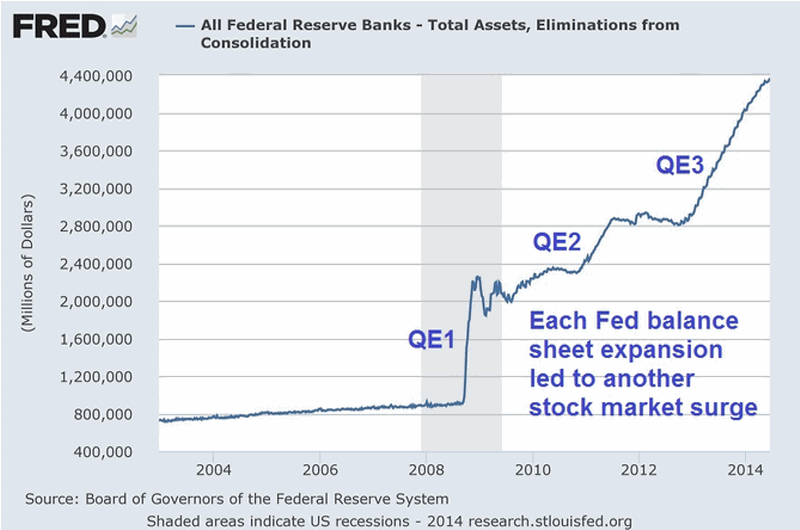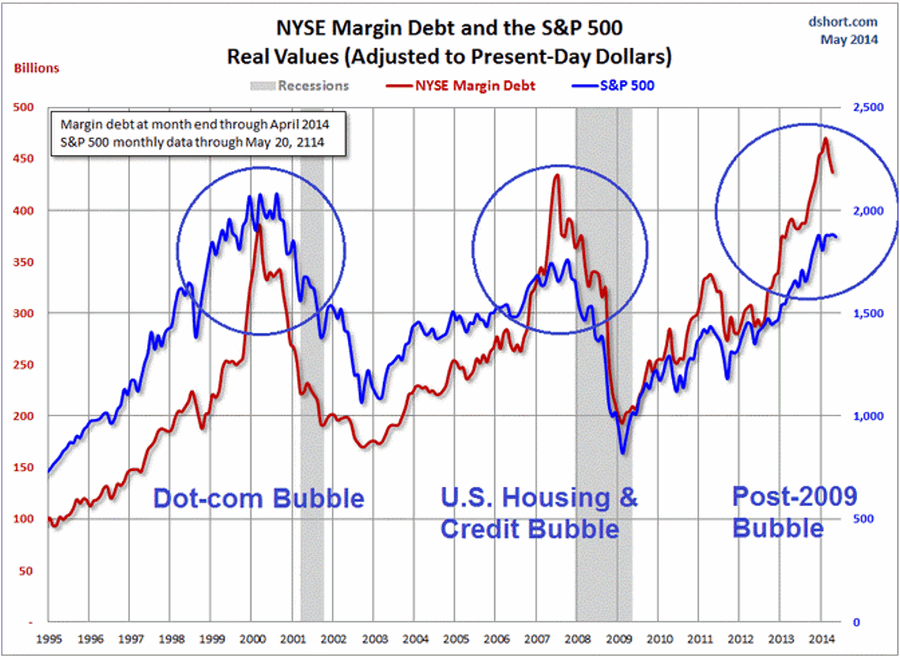Well it finally happened. The stock market actually got “spooked” for a couple of days. It’s been awhile. And that kind of has me “spooked.” Before I go any further I should state the following:
1) I am expecting some “trouble” between now and the end of September
2) However, as a dutiful trend follower I have yet to really act on those fears.
So when I write an article titled “Crash Insurance”, I am not necessarily suggesting that everyone rush out and buy some. I am more or less just “planning ahead.”
I found the following link quite interesting (The 23 Charts Prove That Stocks Are Heading For A Devastating Crash) and suggest you give it a thorough read. Although I don’t necessarily endorse the headline I do think something very unpleasant is quite possible, and the information contained flashes some clear warning signs.
If nothing else see the following:
Chart #4) QE to Infinity and Beyond 
Figure 1 – QE to Infinity and Beyond (Chart Source: Forbes.com article “The 23 Charts Prove That Stocks Are Heading For A Devastating Crash” by Jesse Colombo)
This chart explains as plain as day why we have been in an endless bull market for years now (i.e., money moves the market, and when the Fed provides an endless supply, well, you get the drift). When this chart turns down, be prepared to – all kidding aside – RUN LIKE HELL!
Chart #5) NYSE Margin Debt  Figure 2 – NYSE Margin Debt (Chart Source: Forbes.com article “The 23 Charts Prove That Stocks Are Heading For A Devastating Crash” by Jesse Colombo; Chart generated by Doug Short at DShort.com)
Figure 2 – NYSE Margin Debt (Chart Source: Forbes.com article “The 23 Charts Prove That Stocks Are Heading For A Devastating Crash” by Jesse Colombo; Chart generated by Doug Short at DShort.com)
In the 1975 classic “Market Logic”, Norman Fosback first noted that rising margin debt is bullish for the stock market (once again, money moves the market). He also noted that when margin borrowing gets overdone and then turns down, it’s not such a happy thing for the stock market. As you can see in the chart, the previous two spikes occurred during the run up to the 2000-2002 and 2008 bear markets. The current level has recently declined from a new all-time high. If this downtrend continues it will constitute an important warning sign for investors.
How to Buy “Crash Insurance”
In college I took a class on Insurance (Wow, was I a fun guy or what? I digress). What the teacher taught us was to “spend a little to cover alot.” In other words, spend a small sum of money to cover worst case calamity scenarios (granted this is different then what insurance has evolved into today whereby everyone wants everything to be covered and then wonders why the premium is so high…..but again, I digress).
SPY Put Option
One of the simplest way to “insure” against a market crash is to buy a put option on ticker SPY, the ETF that tracks the S&P 500 Index. As I am looking for a bullish phase to begin on October 1st I need to go out to October options. In Figure 3 we see the “Probability Calculator” screen from www.OptionsAnalysis.com. Highlighted are the potential -1, -2 and -3 standard deviation price levels.
Figure 3 – Probability Calculations for 9/30/14 (Source: www.OptionsAnalysis.com)
The October SPY put option with the lowest “Percent to Double” is the October 198 put option. As I write the option trades at $5.79 (or $579). The risk curve for buying one October 198 put appears in Figure 4. The lower boundary is set to the -3 standard deviation price shown in Figure 3 (166.10). Figure 4 – Risk Curves for October SPY 198 put (Source: www.OptionsAnalysis.com)
Figure 4 – Risk Curves for October SPY 198 put (Source: www.OptionsAnalysis.com)
As you can see in Figure 4, if by chance SPY does fall apart between now and October expiration, this option will gain a lot in value. Of course if the market moves sideways to higher instead this option could expire worthless and the buyer would lose a maximum of $579.
Summary
I am not suggesting that now is the exact right moment to consider buying a put option on SPY. As always I am not “recommending” the trade above. The example I’ve shown is simply intended to give you the idea of how to use put options as a potential alternative to “selling everything”. You should also be aware that via the use of options there are other more “sophisticated” strategies available. Buying a put option to hedge is sort of a “hammer to nail” approach – crude but effective.
In any event, as indicated in the Forbes article in the link above, there are some “clouds beginning to build”. Which leads directly to:
Jay’s Trading Maxim #102: It is better to know where to find shelter now in case an actual storm breaks out than to have to “run for cover” somewhere down the road.
Jay Kaeppel


